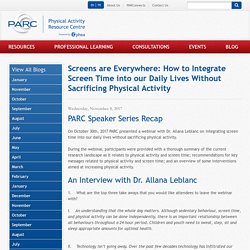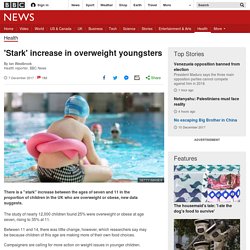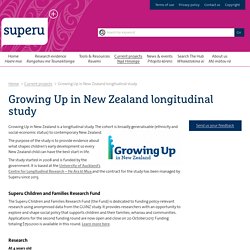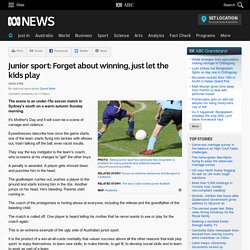

'Make sport accessible and inclusive, and PE can be central to tackling the mental health crisis' A generation is growing up ill-equipped to deal with the daily challenges of the 21st century.

Play More Sports – #changeitup. Nourishingfuturesbetterkai. When Will Youth Sports Actually Serve the Needs of Youth? - Changing the Game Project. Teens in sport summary. Screens are Everywhere: How to Integrate Screen Time into our Daily Lives Without Sacrificing Physical Activity. PARC Speaker Series Recap On October 30th, 2017 PARC presented a webinar with Dr.

Allana Leblanc on integrating screen time into our daily lives without sacrificing physical activity. During the webinar, participants were provided with a thorough summary of the current research landscape as it relates to physical activity and screen time; recommendations for key messages related to physical activity and screen time; and an overview of some interventions aimed at increasing physical activity. An Interview with Dr. Allana Leblanc 1. I. II. III. 2. In six months from now, I would love it if webinar attendees were using some of the key messages I put together in practice. 3.
For me, the most exciting thing about the physical activity world right now is the outdoors. 'Stark' increase in overweight youngsters. Image copyright Getty Images There is a "stark" increase between the ages of seven and 11 in the proportion of children in the UK who are overweight or obese, new data suggests.

The study of nearly 12,000 children found 25% were overweight or obese at age seven, rising to 35% at 11. Between 11 and 14, there was little change, however, which researchers say may be because children of this age are making more of their own food choices. Campaigners are calling for more action on weight issues in younger children. Researchers from the Centre for Longitudinal Studies (CLS) at the UCL Institute of Education analysed information on nearly 12,000 of the children taking part in the Millennium Cohort Study, who were born in 2000 and 2001 and have had their weight and height measured at the ages of three, five, seven, 11 and 14.
Get up and move to improve children's learning. Research on learning not sitting around That is exactly what the team of researchers from Early Start at UOW have discovered, with two recent studies demonstrating that reduced sitting in the classroom and increased physical activity after school, both gave a boost to executive functioning – things like working memory, attention span, ability to focus and avoid distractions and problem solving.

One study concludes that simple measures to break up seated time in the classroom could offer improvements in executive function that were the equivalent of an additional six months of schooling in a traditional classroom environment. “ We need to be thinking about a typical day and how you could replace sedentary activities with non-sedentary ones. Professor Tony Okely.
Children’s everyday exposure to food marketing: an objective analysis using wearable cameras. Bio-banding - Talent development not based on age. For many English footballers, the journey to a place on the national team begins in Premier League football academies.

But home-grown talent doesn't always rise to the top. Players like David Beckham and Steven Gerrard were part of England's 'Golden Generation', but failed to deliver international trophies. As that generation slips into retirement, the country is searching for new talent. The 2014 World Cup squad featured promising young players like Adam Lallana, Raheem Sterling and Ross Barkley. Parliamentary group examines the important role of PE. An All-Party Parliamentary Group (APPG) on a Fit and Healthy Childhood has today released a new report which it has hailed as ‘the most comprehensive blueprint for PE for a generation.’

The APPG report, which includes contributions from the Youth Sport Trust, aims to recognise the vital importance of physical education to health and to create an the environment that will reverse the strong recent trend of reduced physical activity. The ways in which PE is taught in the four home nations and in other countries; the role of PE in the National Curriculum; ways in which girls can be encouraged to participate in PE; an inclusive PE curriculum for disabled children; and PE as part of a health and wellbeing matrix, including knowledge of good nutrition, sport and play; are among the subjects examined in the report. The report provides a series of recommendations to increase the delivery of high quality of PE in schools.
These include calls to: Click here to see the full report. Research & evidence about what works for families & whanau. Growing Up in New Zealand is a longitudinal study.

The cohort is broadly generalisable (ethnicity and social-economic status) to contemporary New Zealand. The purpose of the study is to provide evidence about what shapes children’s early development so every New Zealand child can have the best start in life. The study started in 2008 and is funded by the government. It is based at the University of Auckland’s Centre for Longitudinal Research – He Ara ki Mua and the contract for the study has been managed by Superu since 2013. Junior sport: Forget about winning, just let the kids play. Analysis Updated The scene is an under-15s soccer match in Sydney's south on a warm autumn Sunday morning.

It's Mother's Day and it will soon be a scene of carnage and violence. Eyewitnesses describe how once the game starts, one of the team starts flying into tackles with elbows out, trash talking off the ball, even racist insults. Australian Ninja Warrior breeds a junior generation of athletes. Pupils suffer from 'warped' body image, teachers warn. Almost all teachers say that their pupils are affected by concerns about body image, a survey from the NUT teachers’ union suggests.

As a result of these concerns, many pupils are succumbing to eating disorders or opting out of PE lessons, teachers told the union. One teacher said: “Social media is king at the moment, and they live their lives by what they see on it.” The union surveyed 492 secondary teachers about their pupils’ attitudes to body image. Our ‘sporting nation’ is a myth, so how do we get youngsters back on the field? Sport is seen as a key part of Australia’s identity.

Yet woefully rundown facilities and outdated sport offerings are creating significant barriers to youth participation. In partnership with the Cooks River Sporting Alliance, Canterbury Hurlstone Park RSL Club, and 12 public and private schools from Sydney’s inner west, we’ll be working with youth to co-design an innovative program to reverse the decline in youth participation in sport. Our program, Designing in Youth, will feature new sport offerings, advertising materials and redesigned facilities. Move now for lifelong benefits » Media releases and updates » Sport New Zealand. Back Move now for lifelong benefits It doesn’t take an awful lot to get kids active and having fun, and the lifelong benefits are huge, says Sport NZ’s Young People Lead Jo Colin.
Her message is very much in line with that of the government’s Big Change Starts Small campaign, which aims to encourage parents to start making small changes to ensure long-term and positive impacts on their children's health and wellbeing. Fun, informal activities encourage kids to be spontaneous and creative, and give them the enthusiasm and confidence to stay physically active and access sport and other physical activities, Jo says. Big Change Starts Small. Underserviced Youth: Sports Participation Barriers and Best Practices.
Author: SIRC According to Statistics Canada, children who live in unsafe neighborhoods, children of new immigrants and children coming from low-income families are less likely to participate in sports. For children, joining a sports team is an opportunity to learn, create new friendships, and develop fundamental skills. Being part of a sport team not only keeps kids active but also has many psychological and social benefits. Unfortunately, barriers for some families can influence whether their children can even participate in sports. Challenges to sport participation. Teenage body fears influenced by social media - report. Coaching boys into men via the sports field. Coaching Boys into Men is an initiative set up to engage sports coaches as mentors for young athletes, teaching them the importance of respect for themselves and others, particularly women.
It has run successfully in the United States and has now been launched in Australia, with several sporting codes gathering in Canberra on Monday for a training clinic. Facilitated by Mark Wadie, founding director of the I Respect Initiative and violence prevention advocate, the program centres around training and motivating coaches to teach their players about healthy relationship skills and that violence never equals strength. ISF President Petrynka charged by Bach with bridging global gap for school athletes. Boys and girls from 32 countries gathered in the Croatian city of Porec earlier this month for the World Schools Basketball Championships, with the action streamed live on the Olympic Channel as well as the site of the sport's world governing body, the International Basketball Federation (FIBA).
The event attracted more than 200,000 viewers. It was the latest example of what the International School Sport Federation (ISF) does - on this occasion in conjunction with the Croatian School Sport Federation. We asked children why they don't get enough exercise – here's what they said. Getting children off the sofa, away from the TV and outside can be a challenging task for any parent, particularly in the age of increasingly sedentary and screen-focused lives. To stay healthy, it is currently recommended that children do at least 60 minutes of moderate to vigorous physical activity daily. But this has been in decline in recent years. And now only 21% of boys and 16% of girls in England are meeting current recommendations. Untitled. To tackle childhood obesity we must all be concerned, but also take action.
Why Kids Play Sports - Changing the Game Project. Get off the couch, kids: This startup just raised $1M for a high-tech app-connected ball. Can a high-tech, sensor-infused ball help a generation of device-addicted kids be more active? One startup is about to find out. Seattle-based Play Impossible is coming out of stealth mode and just announced a $1 million investment round that included participation from Two Sigma Ventures, Ben Franklin Technology Partners, and WestRiver Group, the firm led by TopGolf Entertainment Group Co-Chairman Erik Anderson.
The company has developed a smart, connected inflatable ball that looks completely normal from the outside but has a bevy of electronics inside — accelerator, barometer, microcontroller, ultracapacitor, etc. — and sends real-time data via Bluetooth to an accompanying iOS or Android smartphone app, which lets people play different games and record highlight videos. A charging stick gives the ball two hours of play in just 20 seconds. Here’s a quick video that shows some of the games you can play with the connected ball: Here’s a tidbit from Monnin’s recent blog post: Prevent youth sport dropout. Youth insight under the skin. Fighting childhood obesity: Signs of Progress. Youth insight pack. Teenage weight gain down to dramatic drop in calories they burn. An acceleration in obesity among young teenagers could be explained by a 12-year-long study which found that the number of calories they burn while at rest drops suddenly in puberty.
Research led by the University of Exeter Medical School, published in the Nature journal The International Journal of Obesity, found unexpectedly that when they reach puberty, both girls and boys experience a rapid drop in the number of calories they burn – at a time when the number would be expected to rise with the growth spurt. The research by Professor Terence Wilkin, of the University of Exeter Medical School, found that 15-year-olds use 400 to 500 fewer calories while at rest per day compared to when they were 10-years-old – a fall of around a quarter.
But by the age of 16, their calorie expenditure begins to climb once again. Sport for Good. The Power of Sport The power of sport to generate dramatic benefits for young people and disadvantaged communities is harnessed by organisations around the world. This includes local community groups and goes right up to government bodies.
Imaginative projects from Magic Bus in India to Trelya in Cornwall all testify that sport has the X factor. That’s because, by speaking a universal language, sport is able to touch everyone’s life. Survey shows large gender gap in attitudes to physical activity for teenagers. Growing up in NZ now we are 4. Teens Are Just As Sedentary As 60 Year Olds. 2016 U.S. Report Card on Physical Activity for Children and Youth. Analysis shows boys participate in organised sport more than girls. Beyond Olympic gold: US kids getting lapped in aerobic fitness. British children among the least active in the world, with exercise 'stripped out' of modern lives.
2016 ParticipACTION Report Card Highlights. 2016 ParticipACTION Report Card Ful Report. StateofPlay 2016 FINAL. Aspen Institute Project Play Report. Sport for Life Physical Literacy. Why Are Girls Less Physically Active than Boys? Findings from the LOOK Longitudinal Study. Youth personas. Active Healthy Kids Australia - Report Cards. Aussie kids among ‘least active in the world’
AusPlay Summary of Key Findings December16 PDF. Canadian Assessment of Physical Literacy. Relative age and developmental age: Is your child getting shortchanged? - Active For Life. Children's Participation in Organized Sport and Physical Activities and Active Free Play: Exploring the Impact of Time, Gender and Neighbourhood Household Income Using Longitudinal Data.
Changing the Game Project. Can the Social Vulnerability Index Be Used for More Than Emergency Preparedness? An Examination Using Youth Physical Fitness Data. NSW Strategic Plan for Children and Young People consultation results. Project Play. Who We Are. Why do 70 per cent of kids quit sport by age 13? KaiTime Physical Activity and Screen Time summary. BIO-BANDING AND DEVELOPMENTAL AGE. Fitbits could be putting children off exercise. Community led development, Every Child Counts. How to engage more students with golf - Golf Australia. Future Sport Leaders. Young people shape sport in their areas. Strategies for helping coaches facilitate positive youth development through sport. Project Play: Playbook.
Home - Fit For Sport - A Journey to an Active Live. Example of Active Lifestyle Programmes - ParticipACTION. Example of KidSport, successful with aboriginal children, in WA. Playworks (places coaches in low-income urban schools to engage students in physical activity during recess) 60 Minute Kids' Club. Getting young people into sport - Midweek - Wanganui Chronicle News. The Effects of Physical Activity and Fitness in Adolescence on Cognition in Adulthood and the Role of Insulin-Like Growth Factor I. PE to become Leaving Cert subject under new plan to tackle obesity in Ireland.
Sport Calgary All Sport One Day: Home. The 8 Plays: Introduction — Project Play: Playbook. The Daily Mile – Children fit for life. New grant makes youth hockey a reality for the "other 99%" Effects of a school-based physical activity intervention on adiposity in adolescents from economically disadvantaged communities: secondary outcomes of the`Physical Activity 4 Everyone' programme. Bay courts full and basketball numbers still rising. Move and Play at Recess for web. So What Is Developmentally Appropriate Sport? by Richard Bailey.
Study: Active parents have more active kids. 6 Words You Should Say Today. How to get your children active – 10 top tips for parents. The Implications of Screen Time for Young Children. Ukactive Kids Generation Inactive. Study: Active parents have more active kids. When Will What We Know Change What We Do in Youth Sports? - Changing the Game Project. Mom and Me: Active Lifestyles Begin at Home! Kids need active sporty parents. The Accountability Problem in Youth Sports - Changing the Game Project. No more joiners: Why kids are dropping out of sports - CBC Sports - Sporting news, opinion, scores, standings, schedules. Olympians focused on bringing fun back to sport. No more joiners: Why kids are dropping out of sports - CBC Sports - Sporting news, opinion, scores, standings, schedules. Parent myths, and real truths, about physical literacy - Active For Life.